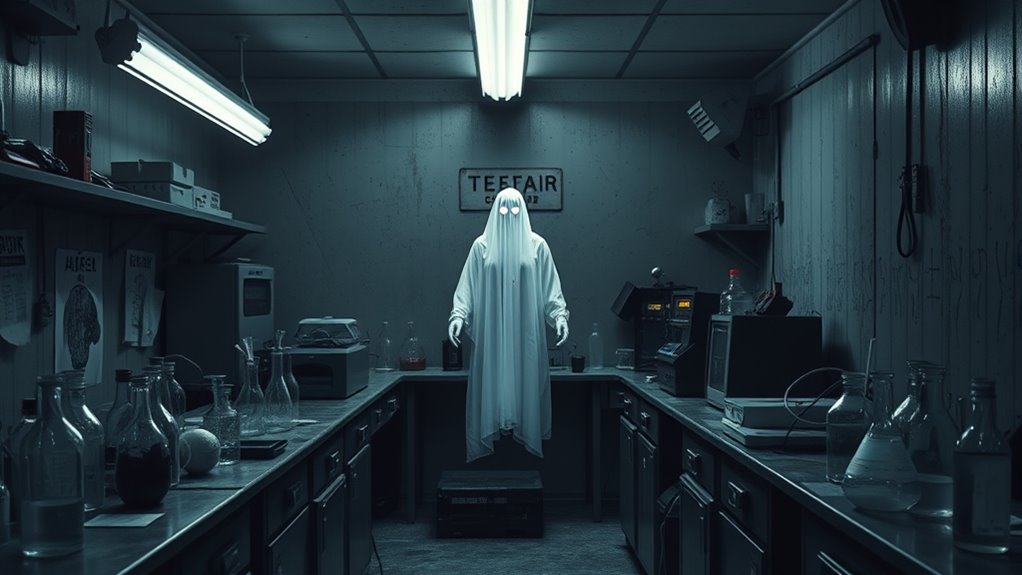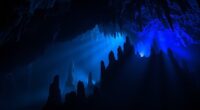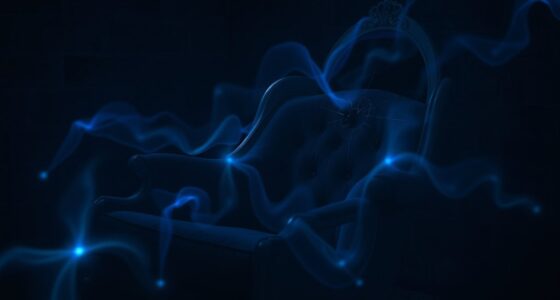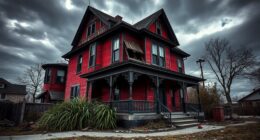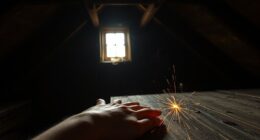Science has developed advanced tools like EMF meters, thermal cameras, and EVP recorders to investigate paranormal claims, but conclusive proof remains elusive. While some experiments detect energy fluctuations or anomalies, these often have natural explanations or lack reproducibility. Skeptics highlight the challenges of subjective perceptions and environmental noise. Despite ongoing efforts and technological progress, true scientific validation of ghosts and spirits hasn’t been achieved yet. Discover more about the challenges and breakthroughs shaping this intriguing field.
Key Takeaways
- Scientific investigations use advanced equipment like EMF meters and thermal cameras to detect potential paranormal activity.
- No conclusive, reproducible evidence has been obtained, keeping the paranormal unproven scientifically.
- Data analysis techniques help distinguish genuine signals from environmental noise, but challenges remain in validation.
- The scientific community emphasizes skepticism, rigorous controls, and peer review before accepting paranormal claims.
- Future research aims to incorporate AI and standardized protocols to enhance the reliability of ghost hunting in labs.
The Historical Pursuit of Paranormal Evidence
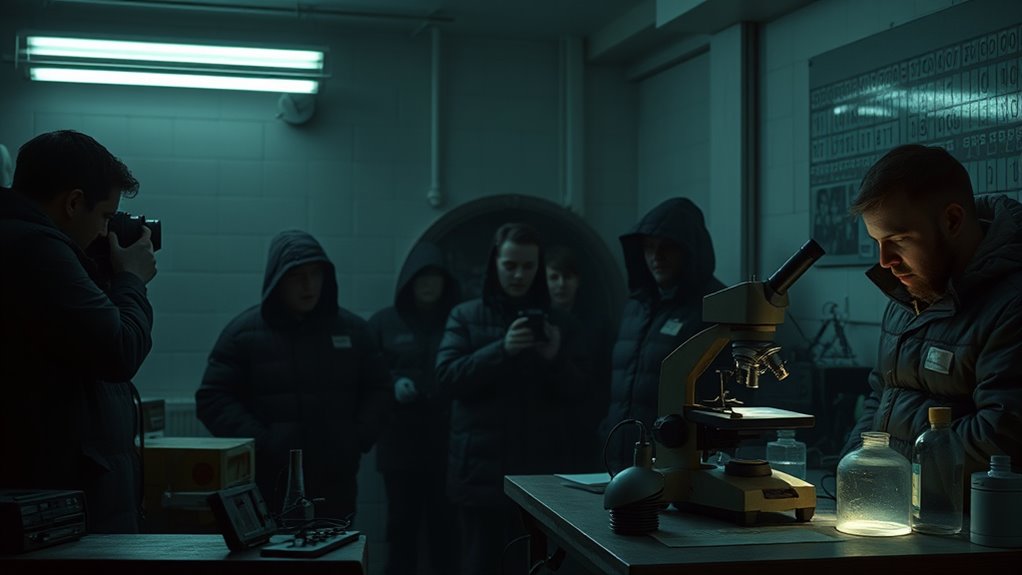
Throughout history, people have actively sought evidence of the paranormal, driven by curiosity and a desire to understand the unknown. Many cultural beliefs and historical myths fuel this pursuit, shaping how societies interpret ghost sightings and spirits. Ancient civilizations, from the Egyptians to the Chinese, documented their stories of spirits and afterlife rituals, often attributing unexplained phenomena to supernatural forces. These beliefs influenced practices and rituals aimed at communicating with the dead or appeasing spirits. Over time, myths became embedded in cultural traditions, reinforcing the idea that the paranormal holds truth. Your ancestors’ stories reflect an enduring human urge to find meaning beyond the physical world, laying the foundation for modern ghost hunting efforts rooted in these age-old beliefs. Additionally, the benefits of spiritual exploration have contributed to the continued fascination with paranormal phenomena throughout history. This persistent interest is also supported by the advances in scientific technology, which have enabled more systematic investigations into unexplained phenomena, although definitive proof remains elusive. Moreover, the development of scientific methods has allowed researchers to approach these mysteries with greater rigor, even if conclusive evidence continues to be elusive. The ongoing public fascination with ghosts demonstrates how deeply ingrained this curiosity remains in human culture. Recent innovations in paranormal investigation tools have further fueled the quest to find scientific validation for ghostly encounters.
Scientific Methods in Modern Ghost Investigations

Modern ghost investigations rely heavily on advanced technological equipment to detect unexplained phenomena. You’ll also use data analysis techniques to interpret the information collected, helping to separate genuine activity from false signals. By combining these methods, you can approach paranormal research with a scientific rigor that adds credibility to your findings. Incorporating evidence-based practices is essential for ensuring the reliability of your observations. Utilizing modern technology such as thermal imaging and electromagnetic field meters can further enhance the accuracy of your investigations. Additionally, understanding the importance of contrast ratio in imaging devices can improve the clarity of visual data collected during these investigations. Staying vigilant about cybersecurity measures is crucial to protect your data from potential interference or tampering during investigations. Developing strong communication skills can also facilitate better collaboration and data sharing among investigators.
Technological Equipment Utilization
To investigate claims of paranormal activity scientifically, you rely heavily on advanced technological equipment designed to detect anomalies in the environment. Devices like electromagnetic field (EMF) meters help measure fluctuations that might indicate supernatural presence. Some investigators also explore quantum entanglement theories, believing that if particles are linked across distances, they could influence paranormal phenomena. By monitoring electromagnetic fields, you can identify unusual spikes or disturbances that aren’t easily explained by natural causes. Additionally, understanding environmental considerations such as natural electromagnetic interference ensures that the data collected is accurate and ethically obtained. Incorporating these scientific approaches enhances the reliability of your findings and helps distinguish between genuine anomalies and natural occurrences. These methods demonstrate how a creative practice applies beyond traditional art forms, emphasizing systematic exploration and analysis. Although these technologies don’t prove the paranormal definitively, they serve as critical instruments in the ongoing effort to understand and potentially validate ghostly encounters scientifically. Furthermore, utilizing modern detection tools like thermal imaging cameras can reveal hidden or cold spots associated with ghostly activity, adding another layer of scientific investigation.
Data Analysis Techniques
When analyzing data collected during ghost investigations, you rely on rigorous scientific methods to distinguish genuine anomalies from natural noise. Statistical modeling helps identify patterns that stand out from background fluctuations, ensuring you don’t mistake everyday interference for paranormal activity. Data visualization then turns complex datasets into clear, visual formats like graphs or heat maps, making anomalies easier to interpret. These techniques allow you to see trends, correlations, and outliers at a glance, providing objective evidence that supports or questions paranormal claims. By applying precise data analysis methods, you improve the reliability of your findings, moving beyond anecdotal reports. Additionally, understanding the divorce process in various states helps you appreciate the importance of structured procedures and reliable data handling in scientific investigations. Ultimately, these scientific tools help you rigorously evaluate suspicious phenomena, ensuring your conclusions are grounded in solid evidence rather than assumptions.
The Role of Technology and Equipment
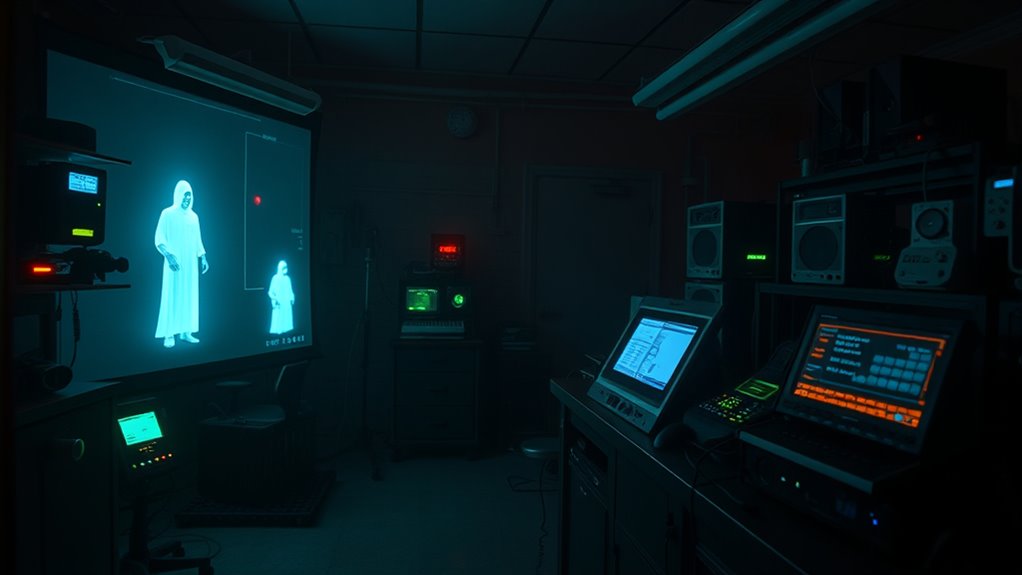
Technology and equipment play a essential role in ghost hunting by providing tools that help detect and document paranormal activity. Devices like EMF meters, thermal cameras, and EVP recorders aim to capture phenomena that might relate to quantum mechanics or emotional responses. These tools can identify subtle changes in energy or temperature, which could indicate paranormal presence. You might also use spirit boxes to scan for voices or signals, offering insights into potential consciousness beyond our understanding. Keep in mind, while these tools are valuable, they don’t guarantee proof. They serve as indicators that require careful interpretation. Your goal is to gather objective data, balancing scientific rigor with an awareness of how emotional responses can influence perceptions during investigations.
Notable Experiments and Studies
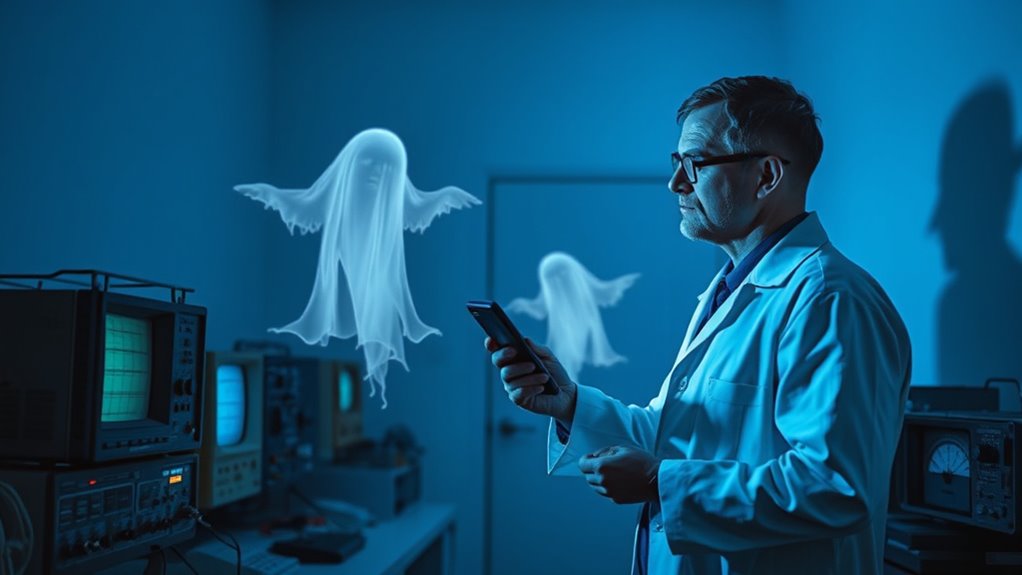
Many experiments have used specialized equipment like EMF meters and thermal cameras to detect anomalies, sparking curiosity about their results. Some studies report intriguing findings, such as unexplained energy fluctuations, while others remain inconclusive. The scientific community largely responds with skepticism, demanding more rigorous evidence before accepting these claims.
Notable Equipment Used
Numerous devices have become vital in ghost hunting investigations, each designed to detect anomalies that might indicate paranormal activity. These tools often focus on electromagnetic fields, as fluctuations could suggest unseen energies. Equipment like EMF meters monitor electromagnetic disturbances, which some believe are linked to spirits. Additionally, devices inspired by quantum mechanics aim to detect subtle quantum fluctuations that could indicate paranormal presence.
- EMF meters track electromagnetic field changes
- Thermographic cameras reveal temperature anomalies
- Audio recorders capture EVP (Electronic Voice Phenomena)
While these tools help identify unusual phenomena, their effectiveness relies on understanding how electromagnetic fields and quantum effects might relate to spirits. This equipment offers a scientific approach, but it’s vital to interpret results carefully.
Key Experimental Findings
Several experiments have sought to verify the presence of paranormal activity through scientific methods, yielding intriguing and sometimes controversial results. Researchers often explore electromagnetic anomalies and quantum entanglement, hoping to find evidence of spirits or otherworldly influences. For example, some studies report unusual fluctuations in electromagnetic fields during supposed paranormal encounters. Others investigate quantum entanglement, suggesting particles may be linked across distances in ways that could explain ghostly phenomena. While these findings are provocative, they remain debated within the scientific community. Below is a summary of notable experimental results:
| Experiment/Study | Key Findings |
|---|---|
| Electromagnetic surveys | Detected anomalies correlating with reported activity |
| Quantum entanglement tests | Possible non-local connections in paranormal cases |
| EVP recordings | Some attribute to electromagnetic interference |
| Laboratory simulations | Minimal evidence supporting paranormal influence |
Scientific Community’s Response
The scientific community approaches claims of paranormal activity with both curiosity and skepticism, scrutinizing experimental results for validity. They seek scientific validation through rigorous testing and peer review, often highlighting the importance of controls and reproducibility. When notable experiments emerge, they are examined critically, focusing on whether they withstand scrutiny or fall short due to flaws.
Key points include:
- Many studies lack proper controls, fueling paranormal skepticism.
- Reproducibility remains a challenge in paranormal research.
- Some experiments suggest potential phenomena but lack conclusive evidence.
While some researchers remain open-minded, most emphasize the need for replicable results before accepting paranormal claims. This cautious approach helps ensure that scientific validation isn’t rushed, maintaining integrity in the quest to understand the unknown.
Challenges in Validating Paranormal Phenomena

Validating paranormal phenomena presents a significant challenge because such events often lack consistent, reproducible evidence that can be tested under controlled conditions. Your observations may be influenced by subjectivity biases, making it difficult to distinguish genuine phenomena from perception errors or expectations. Scientific methods rely on reproducibility, but paranormal events tend to be unpredictable and rare, complicating efforts to verify them objectively. Additionally, ethical dilemmas arise when designing experiments that could mislead or distress participants or when attempting to manipulate or recreate sensitive situations. These challenges hinder scientific progress because they cast doubt on the reliability of evidence and force researchers to question whether they can ever truly validate paranormal claims through empirical means.
Psychological Factors and Perception
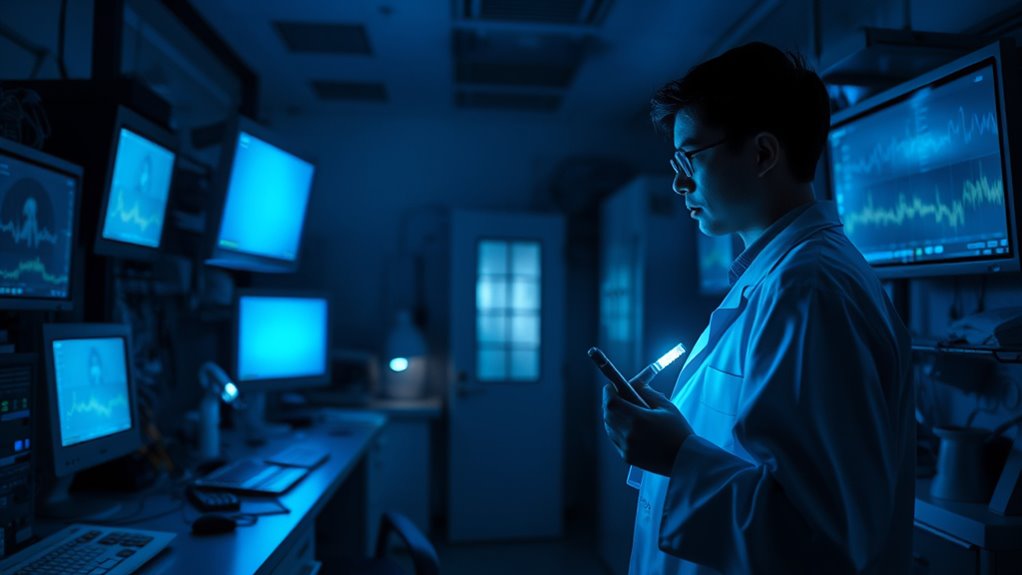
Psychological factors and perception play a crucial role in how you interpret paranormal events. Your brain is prone to cognitive biases that can distort reality, leading you to see what you expect or fear. Perceptual illusions, such as pareidolia, can make you perceive faces or figures where none exist. These mental shortcuts and misinterpretations often influence your experiences, making you more likely to believe in supernatural activity. For example, you might:
- Attribute unexplained sounds to ghosts instead of natural causes
- Misinterpret shadowy figures as spirits due to visual illusions
- Recall events in a way that confirms your beliefs, thanks to confirmation bias
Understanding these psychological influences helps explain why many claims of paranormal encounters may stem from perception rather than actual phenomena.
Future Directions for Scientific Ghost Research
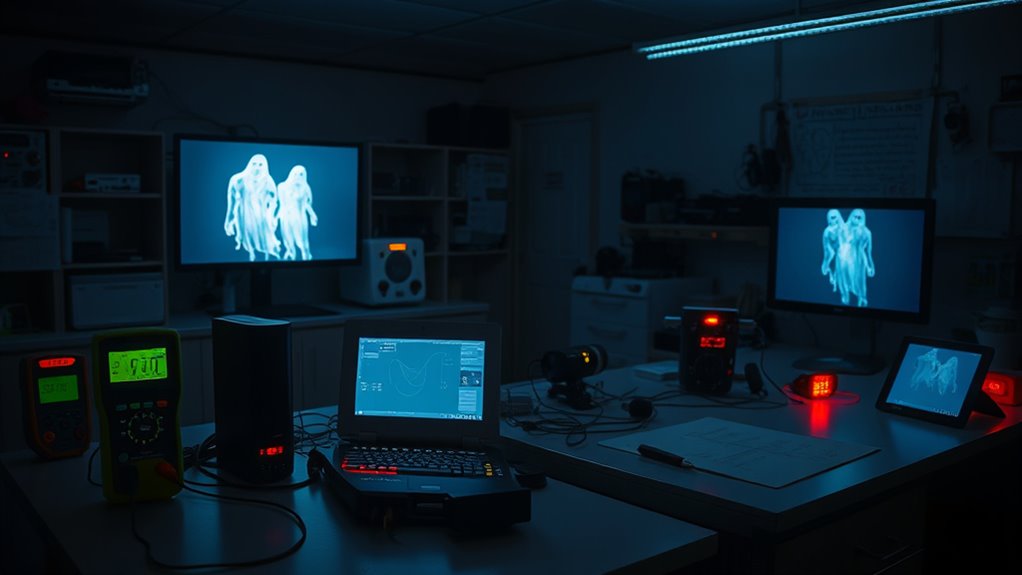
Advancements in technology and scientific methodologies are shaping the future of ghost research, offering new tools to investigate paranormal claims objectively. Emerging techniques, like high-resolution sensors and AI analysis, promise more accurate results. However, ethical dilemmas and funding obstacles remain significant challenges. Ethical concerns about privacy and consent may limit certain experiments, while limited funding hampers large-scale studies. To navigate these issues, researchers must prioritize transparency and seek diverse funding sources. The table below highlights key future directions and hurdles:
| Future Directions | Opportunities | Challenges |
|---|---|---|
| Integrating AI and machine learning | Enhanced data analysis | Ethical dilemmas in data use |
| Developing portable equipment | Field research flexibility | Funding obstacles |
| Cross-disciplinary collaboration | Broader scientific support | Ethical oversight complexities |
| Standardizing protocols | Reliable, comparable results | Limited funding streams |
| Public engagement and education | Increased support | Overcoming skepticism |
Frequently Asked Questions
Can Ghost Sightings Be Completely Explained by Science?
You wonder if ghost sightings can be fully explained by science. While some believe psychological biases, like suggestibility, influence perceptions, scientific theories like quantum entanglement suggest potential connections we don’t fully understand yet. However, many sightings remain unverified, and scientific proof is lacking. So, although science offers explanations, it’s unlikely to completely account for all ghost sightings without further evidence.
Are There Any Conclusive Scientific Proofs of Ghosts?
You wonder if there’s conclusive scientific proof of ghosts. While historical accounts describe apparitions, modern science hasn’t confirmed their existence due to technological limitations. For example, some studies have used EMF detectors to find supposed paranormal activity, but these results often lack replicability. Currently, no scientific evidence definitively proves ghosts, leaving the question open-ended. You need more advanced tools and rigorous research to draw firm conclusions.
How Do Different Cultures Interpret Paranormal Phenomena Scientifically?
You’ll find that different cultures interpret paranormal phenomena through their unique cultural beliefs and scientific interpretations. Some see spirits as spiritual entities, while others view strange occurrences as psychological or environmental effects. Scientific interpretations often focus on natural explanations, like hallucinations or electromagnetic interference. By understanding these diverse perspectives, you gain insight into how cultural beliefs shape your perception of the paranormal, blending tradition and science in fascinating ways.
What Are the Ethical Considerations in Scientific Ghost Research?
When exploring scientific ghost research, you must consider ethical issues like informed consent and data integrity. You’re responsible for ensuring participants understand the study’s purpose and potential risks, respecting their autonomy. Maintaining data integrity means accurately recording results and avoiding manipulation. By prioritizing transparency and honesty, you help build trust and credibility in your research, ensuring your work aligns with ethical standards and advances the scientific understanding of paranormal phenomena.
Can Scientific Methods Distinguish Between Genuine and Fabricated Paranormal Reports?
You wonder if scientific methods can tell real paranormal reports from fake ones. Paranormal skepticism pushes researchers to use careful scientific validation, looking for consistent, measurable evidence. By applying rigorous tests, you can differentiate between genuine phenomena and fabricated claims. While science can’t yet definitively prove the paranormal, it can help identify trustworthy reports and debunk false ones, ensuring your investigations are grounded in credible evidence.
Conclusion
As you explore the world of ghost hunting, remember that every flicker of EMF or sudden noise might just be a coincidence—like shadows dancing at dusk. Science seeks to find answers, but the line between coincidence and reality often blurs, much like mist rolling over an empty graveyard. Until we can reliably distinguish the two, the paranormal remains a tantalizing mystery, inviting you to look closer, question more, and wonder what’s truly out there in the shadows.
